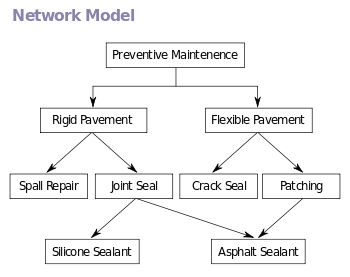Network model

The network model is a database model conceived as a flexible way of representing objects and their relationships. Its distinguishing feature is that the schema, viewed as a graph in which object types are nodes and relationship types are arcs, is not restricted to being a hierarchy or lattice.
Overview
While the hierarchical database model structures data as a tree of records, with each record having one parent record and many children, the network model allows each record to have multiple parent and child records, forming a generalized graph structure. This property applies at two levels: the schema is a generalized graph of record types connected by relationship types (called "set types" in CODASYL), and the database itself is a generalized graph of record occurrences connected by relationships (CODASYL "sets"). Cycles are permitted at both levels. The chief argument in favour of the network model, in comparison to the hierarchical model, was that it allowed a more natural modeling of relationships between entities. Although the model was widely implemented and used, it failed to become dominant for two main reasons. Firstly, IBM chose to stick to the hierarchical model with semi-network extensions in their established products such as IMS and DL/I. Secondly, it was eventually displaced by the relational model, which offered a higher-level, more declarative interface. Until the early 1980s the performance benefits of the low-level navigational interfaces offered by hierarchical and network databases were persuasive for many large-scale applications, but as hardware became faster, the extra productivity and flexibility of the relational model led to the gradual obsolescence of the network model in corporate enterprise usage.
History
The network model's original inventor was Charles Bachman, and it was developed into a standard specification published in 1969 by the Conference on Data Systems Languages (CODASYL) Consortium. This was followed by a second publication in 1971, which became the basis for most implementations. Subsequent work continued into the early 1980s, culminating in an ISO specification, but this had little influence on products.
Database systems
Some well-known database systems that use the network model include:
- Integrated Data Store (IDS)
- IDMS (Integrated Database Management System)
- RDM Embedded
- RDM Server
- TurboIMAGE
- Univac DMS-1100
See also
Further reading
- Charles W. Bachman, The Programmer as Navigator. ACM Turing Award lecture, Communications of the ACM, Volume 16, Issue 11, 1973, pp. 653–658, ISSN 0001-0782, doi:10.1145/355611.362534
External links
| Wikimedia Commons has media related to Network models. |
- CODASYL Systems Committee "Survey of Data Base Systems", 1968 (edited and annotated in 2007 by Ken North)
- Network (CODASYL) Data Model